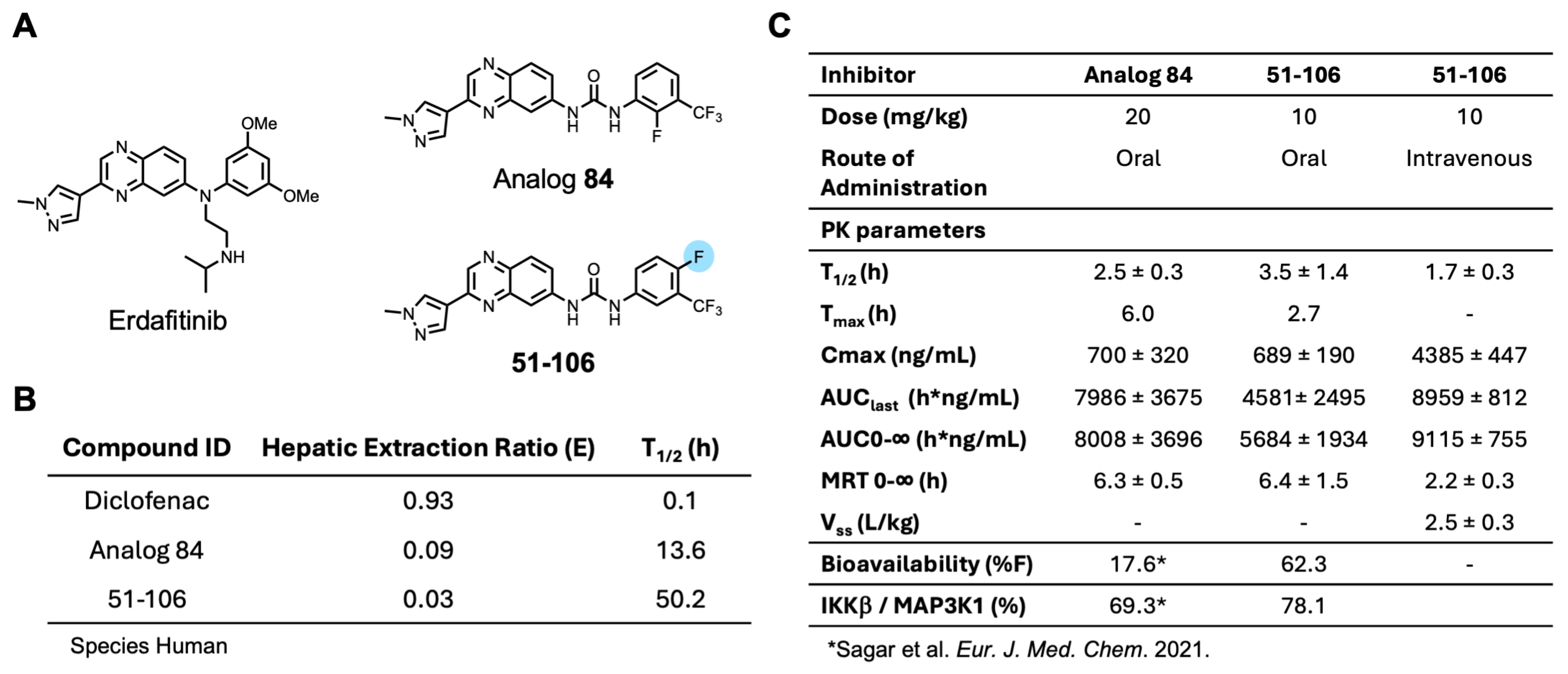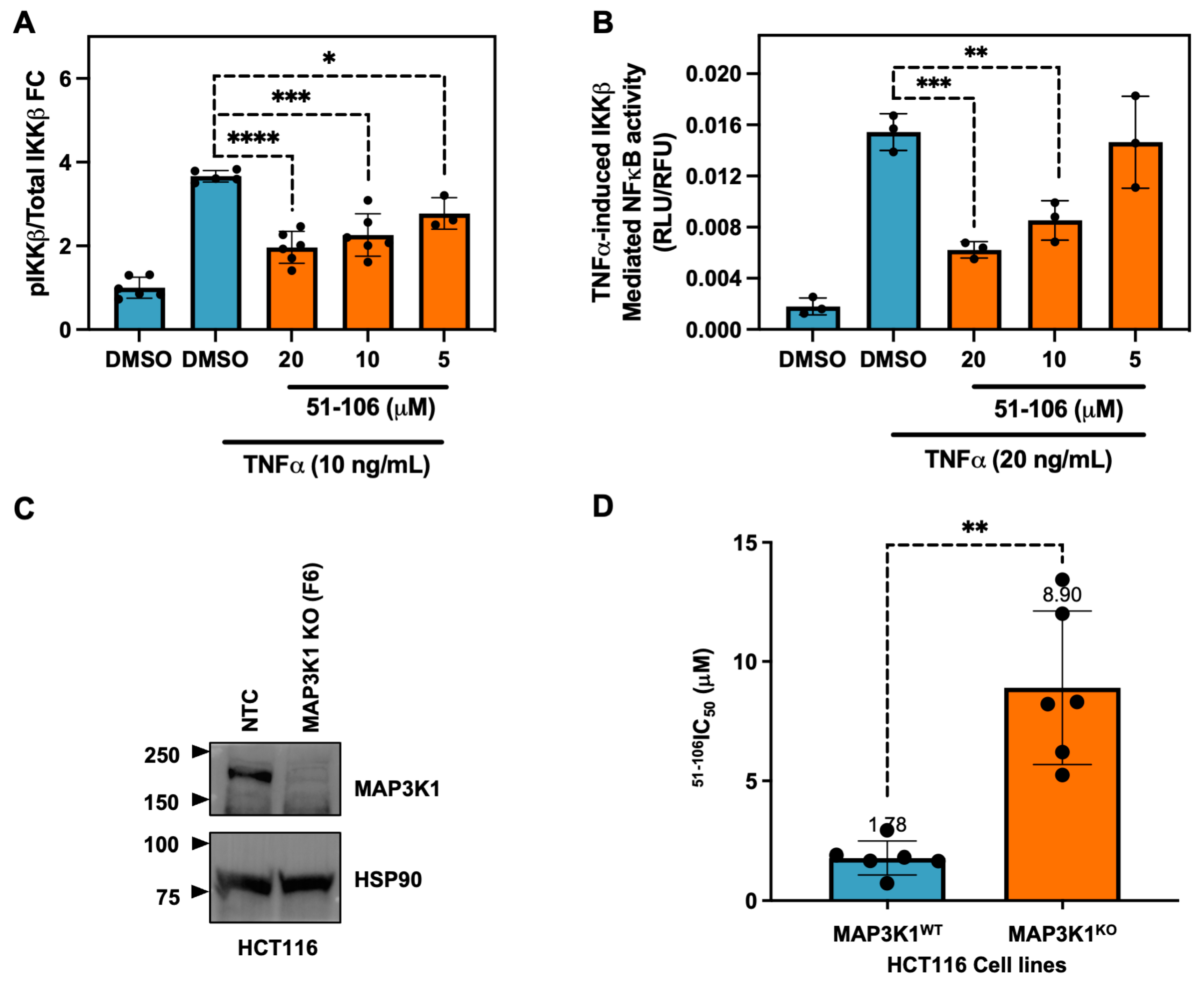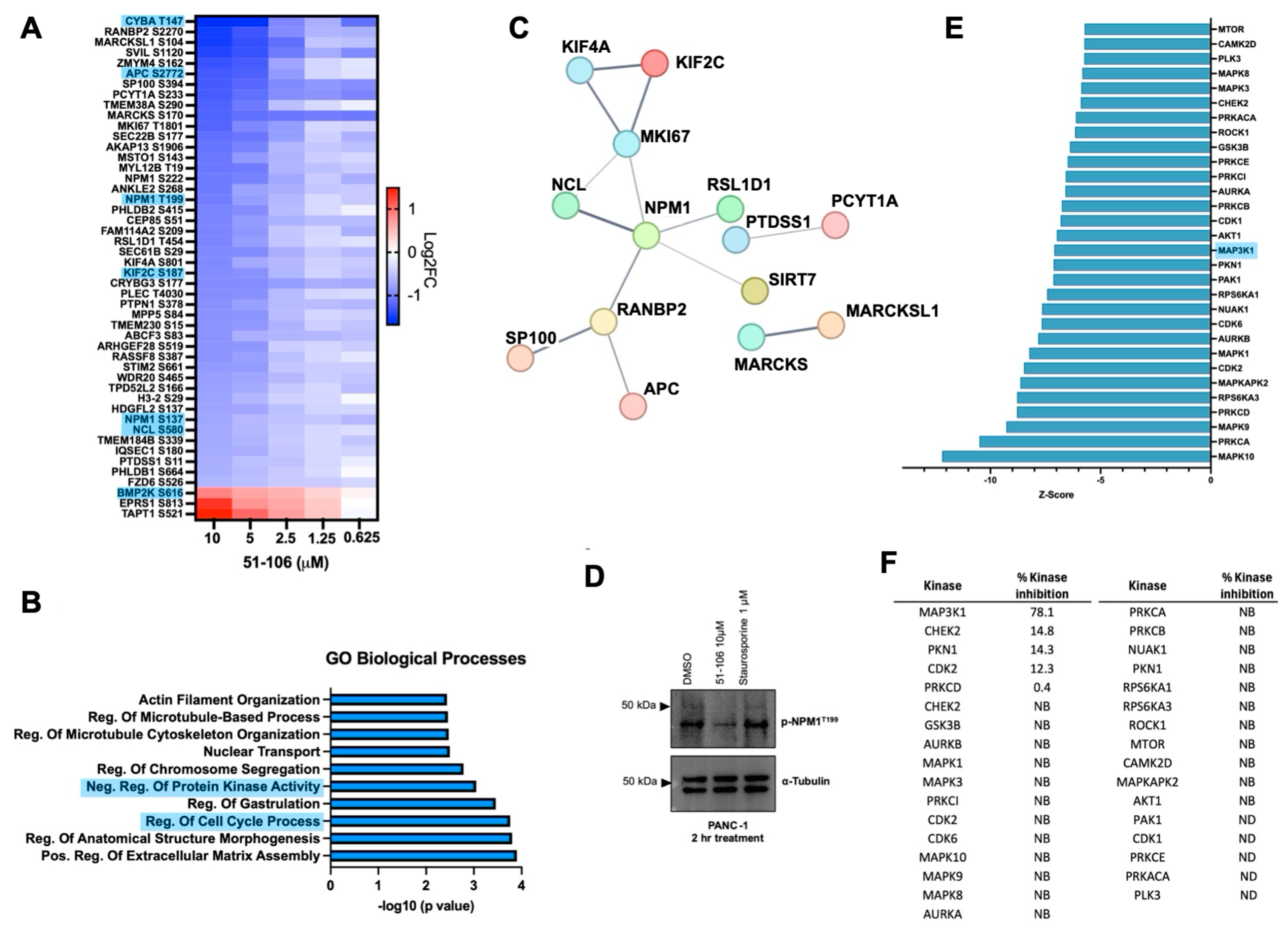A Selective MAP3K1 Inhibitor Facilitates Discovery of NPM1 as a Member of the Network
Abstract
1. Introduction
2. Results and Discussion
3. Materials and Methods
3.1. Synthesis of 1-(4-Fluoro-3-(trifluoromethyl)phenyl)-3-(3-(1-methyl-1H-pyrazol-4-yl)quinoxalin-6-yl)urea (51-106)
3.2. Metabolic Stability and Pharmacokinetics Studies
3.3. AlphaLISA Reporter Assay
3.4. Luciferase Reporter Assay
3.5. Cell Viability Assay
3.6. Western Blotting
3.7. Proteomics
3.8. Docking Studies
4. Conclusions
Supplementary Materials
Author Contributions
Funding
Data Availability Statement
Acknowledgments
Conflicts of Interest
References
- Cuevas, B.D.; Abell, A.N.; Johnson, G.L. Role of mitogen-activated protein kinase kinase kinases in signal integration. Oncogene 2007, 26, 3159–3171. [Google Scholar] [PubMed]
- Pham, T.T.; Angus, S.P.; Johnson, G.L. MAP3K1: Genomic Alterations in Cancer and Function in Promoting Cell Survival or Apoptosis. Genes Cancer 2013, 4, 419–426. [Google Scholar] [CrossRef] [PubMed]
- Minden, A.; Lin, A.; McMahon, M.; Lange-Carter, C.; Derijard, B.; Davis, R.J.; Johnson, G.L.; Karin, M. Differential activation of ERK and JNK mitogen-activated protein kinases by Raf-1 and MEKK. Science 1994, 266, 1719–1723. [Google Scholar] [CrossRef] [PubMed]
- Hirai, S.; Noda, K.; Moriguchi, T.; Nishida, E.; Yamashita, A.; Deyama, T.; Fukuyama, K.; Ohno, S. Differential activation of two JNK activators, MKK7 and SEK1, by MKN28-derived nonreceptor serine/threonine kinase/mixed lineage kinase 2. J. Biol. Chem. 1998, 273, 7406–7412. [Google Scholar]
- Siow, Y.L.; Kalmar, G.B.; Sanghera, J.S.; Tai, G.; Oh, S.S.; Pelech, S.L. Identification of two essential phosphorylated threonine residues in the catalytic domain of Mekk1. Indirect activation by Pak3 and protein kinase C. J. Biol. Chem. 1997, 272, 7586–7594. [Google Scholar] [CrossRef]
- Yan, M.; Dai, T.; Deak, J.C.; Kyriakis, J.M.; Zon, L.I.; Woodgett, J.R.; Templeton, D.J. Activation of stress-activated protein kinase by MEKK1 phosphorylation of its activator SEK1. Nature 1994, 372, 798–800. [Google Scholar] [CrossRef]
- Hagemann, C.; Blank, J.L. The ups and downs of MEK kinase interactions. Cell Signal. 2001, 13, 863–875. [Google Scholar]
- Gardner, A.M.; Vaillancourt, R.R.; Lange-Carter, C.A.; Johnson, G.L. MEK-1 phosphorylation by MEK kinase, Raf, and mitogen-activated protein kinase: Analysis of phosphopeptides and regulation of activity. Mol. Biol. Cell 1994, 5, 193–201. [Google Scholar] [CrossRef]
- Gardner, K.; Moore, T.C.; Davis-Smyth, T.; Krutzsch, H.; Levens, D. Purification and characterization of a multicomponent AP-1.junD complex from T cells. Dependence on a separate cellular factor for enhanced DNA binding activity. J. Biol. Chem. 1994, 269, 32963–32971. [Google Scholar] [CrossRef]
- Xia, Y.; Wu, Z.; Su, B.; Murray, B.; Karin, M. JNKK1 organizes a MAP kinase module through specific and sequential interactions with upstream and downstream components mediated by its amino-terminal extension. Genes Dev. 1998, 12, 3369–3381. [Google Scholar] [CrossRef]
- Guan, Z.; Buckman, S.Y.; Pentland, A.P.; Templeton, D.J.; Morrison, A.R. Induction of cyclooxygenase-2 by the activated MEKK1 --> SEK1/MKK4 --> p38 mitogen-activated protein kinase pathway. J. Biol. Chem. 1998, 273, 12901–12908. [Google Scholar] [CrossRef] [PubMed]
- Lee, F.S.; Hagler, J.; Chen, Z.J.; Maniatis, T. Activation of the IkappaB alpha kinase complex by MEKK1, a kinase of the JNK pathway. Cell 1997, 88, 213–222. [Google Scholar] [CrossRef] [PubMed]
- Lee, F.S.; Peters, R.T.; Dang, L.C.; Maniatis, T. MEKK1 activates both IkappaB kinase alpha and IkappaB kinase beta. Proc. Natl. Acad. Sci. USA 1998, 95, 9319–9324. [Google Scholar] [CrossRef] [PubMed]
- Bonvin, C.; Guillon, A.; van Bemmelen, M.X.; Gerwins, P.; Johnson, G.L.; Widmann, C. Role of the amino-terminal domains of MEKKs in the activation of NF kappa B and MAPK pathways and in the regulation of cell proliferation and apoptosis. Cell Signal. 2002, 14, 123–131. [Google Scholar] [CrossRef]
- Su, F.; Li, H.; Yan, C.; Jia, B.; Zhang, Y.; Chen, X. Depleting MEKK1 expression inhibits the ability of invasion and migration of human pancreatic cancer cells. J. Cancer Res. Clin. Oncol. 2009, 135, 1655–1663. [Google Scholar] [CrossRef]
- Hirano, T.; Shino, Y.; Saito, T.; Komoda, F.; Okutomi, Y.; Takeda, A.; Ishihara, T.; Yamaguchi, T.; Saisho, H.; Shirasawa, H. Dominant negative MEKK1 inhibits survival of pancreatic cancer cells. Oncogene 2002, 21, 5923–5928. [Google Scholar] [CrossRef]
- Bacher, S.; Stekman, H.; Farah, C.M.; Karger, A.; Kracht, M.; Schmitz, M.L. MEKK1-Dependent Activation of the CRL4 Complex Is Important for DNA Damage-Induced Degradation of p21 and DDB2 and Cell Survival. Mol. Cell Biol. 2021, 41, e0008121. [Google Scholar] [CrossRef]
- Rajule, R.; Bryant, V.C.; Lopez, H.; Luo, X.; Natarajan, A. Perturbing pro-survival proteins using quinoxaline derivatives: A structure-activity relationship study. Bioorg Med. Chem. 2012, 20, 2227–2234. [Google Scholar] [CrossRef]
- Chen, Q.; Bryant, V.C.; Lopez, H.; Kelly, D.L.; Luo, X.; Natarajan, A. 2,3-Substituted quinoxalin-6-amine analogs as antiproliferatives: A structure-activity relationship study. Bioorg Med. Chem. Lett. 2011, 21, 1929–1932. [Google Scholar] [CrossRef]
- Napoleon, J.V.; Singh, S.; Rana, S.; Bendjennat, M.; Kumar, V.; Kizhake, S.; Palermo, N.Y.; Ouellette, M.M.; Huxford, T.; Natarajan, A. Small molecule binding to inhibitor of nuclear factor kappa-B kinase subunit beta in an ATP non-competitive manner. Chem. Commun. 2021, 57, 4678–4681. [Google Scholar] [CrossRef]
- Maroni, D.; Rana, S.; Mukhopadhyay, C.; Natarajan, A.; Naramura, M. A quinoxaline urea analog uncouples inflammatory and pro-survival functions of IKKbeta. Immunol. Lett. 2015, 168, 319–324. [Google Scholar] [CrossRef] [PubMed]
- Radhakrishnan, P.; Bryant, V.C.; Blowers, E.C.; Rajule, R.N.; Gautam, N.; Anwar, M.M.; Mohr, A.M.; Grandgenett, P.M.; Bunt, S.K.; Arnst, J.L.; et al. Targeting the NF-kappaB and mTOR pathways with a quinoxaline urea analog that inhibits IKKbeta for pancreas cancer therapy. Clin. Cancer Res. 2013, 19, 2025–2035. [Google Scholar] [CrossRef] [PubMed]
- Gautam, N.; Bathena, S.P.; Chen, Q.; Natarajan, A.; Alnouti, Y. Pharmacokinetics, protein binding and metabolism of a quinoxaline urea analog as an NF-kappaB inhibitor in mice and rats by LC-MS/MS. Biomed. Chromatogr. 2013, 27, 900–909. [Google Scholar] [CrossRef] [PubMed]
- Chaturvedi, N.K.; Rajule, R.N.; Shukla, A.; Radhakrishnan, P.; Todd, G.L.; Natarajan, A.; Vose, J.M.; Joshi, S.S. Novel Treatment for Mantle Cell Lymphoma Including Therapy-Resistant Tumor by NF-kappaB and mTOR Dual-Targeting Approach. Mol. Cancer Ther. 2013, 12, 2006–2017. [Google Scholar] [CrossRef]
- Sagar, S.; Singh, S.; Mallareddy, J.R.; Sonawane, Y.A.; Napoleon, J.V.; Rana, S.; Contreras, J.I.; Rajesh, C.; Ezell, E.L.; Kizhake, S.; et al. Structure activity relationship (SAR) study identifies a quinoxaline urea analog that modulates IKKbeta phosphorylation for pancreatic cancer therapy. Eur. J. Med. Chem. 2021, 222, 113579. [Google Scholar] [CrossRef]
- Beg, S.; Swain, S.; Rizwan, M.; Irfanuddin, M.; Malini, D.S. Bioavailability enhancement strategies: Basics, formulation approaches and regulatory considerations. Curr. Drug Deliv. 2011, 8, 691–702. [Google Scholar] [CrossRef]
- Saxty, G.; Murray, C.W.; Berdini, V.; Besong, G.E.; Hamlett, C.C.F.; Johnson, C.N.; Woodhead, S.J.; Reader, M.; Rees, D.C.; Mevellec, L.A.; et al. Pyrazolyl Quinazoline Kinase Inhibitors. WO 2011/135376 A1, 2011.
- Herrera, J.E.; Savkur, R.; Olson, M.O. The ribonuclease activity of nucleolar protein B23. Nucleic Acids Res. 1995, 23, 3974–3979. [Google Scholar] [CrossRef]
- Spector, D.L.; Ochs, R.L.; Busch, H. Silver staining, immunofluorescence, and immunoelectron microscopic localization of nucleolar phosphoproteins B23 and C23. Chromosoma 1984, 90, 139–148. [Google Scholar] [CrossRef]
- Yung, B.Y.; Busch, H.; Chan, P.K. Translocation of nucleolar phosphoprotein B23 (37 kDa/pI 5.1) induced by selective inhibitors of ribosome synthesis. Biochim. Biophys. Acta 1985, 826, 167–173. [Google Scholar] [CrossRef]
- Tarapore, P.; Shinmura, K.; Suzuki, H.; Tokuyama, Y.; Kim, S.H.; Mayeda, A.; Fukasawa, K. Thr199 phosphorylation targets nucleophosmin to nuclear speckles and represses pre-mRNA processing. FEBS Lett. 2006, 580, 399–409. [Google Scholar] [CrossRef]
- Brunetti, L.; Gundry, M.C.; Goodell, M.A. New insights into the biology of acute myeloid leukemia with mutated NPM1. Int. J. Hematol. 2019, 110, 150–160. [Google Scholar] [CrossRef] [PubMed]
- Cela, I.; Di Matteo, A.; Federici, L. Nucleophosmin in Its Interaction with Ligands. Int. J. Mol. Sci. 2020, 21, 4885. [Google Scholar] [CrossRef] [PubMed]
- Okuwaki, M.; Iwamatsu, A.; Tsujimoto, M.; Nagata, K. Identification of nucleophosmin/B23, an acidic nucleolar protein, as a stimulatory factor for in vitro replication of adenovirus DNA complexed with viral basic core proteins. J. Mol. Biol. 2001, 311, 41–55. [Google Scholar] [CrossRef] [PubMed]
- Takemura, M.; Sato, K.; Nishio, M.; Akiyama, T.; Umekawa, H.; Yoshida, S. Nucleolar protein B23.1 binds to retinoblastoma protein and synergistically stimulates DNA polymerase alpha activity. J. Biochem. 1999, 125, 904–909. [Google Scholar] [CrossRef]
- Borer, R.A.; Lehner, C.F.; Eppenberger, H.M.; Nigg, E.A. Major nucleolar proteins shuttle between nucleus and cytoplasm. Cell 1989, 56, 379–390. [Google Scholar] [CrossRef]
- Valdez, B.C.; Perlaky, L.; Henning, D.; Saijo, Y.; Chan, P.K.; Busch, H. Identification of the nuclear and nucleolar localization signals of the protein p120. Interaction with translocation protein B23. J. Biol. Chem. 1994, 269, 23776–23783. [Google Scholar] [CrossRef]
- Koike, A.; Nishikawa, H.; Wu, W.; Okada, Y.; Venkitaraman, A.R.; Ohta, T. Recruitment of phosphorylated NPM1 to sites of DNA damage through RNF8-dependent ubiquitin conjugates. Cancer Res. 2010, 70, 6746–6756. [Google Scholar] [CrossRef]
- Lee, S.Y.; Park, J.H.; Kim, S.; Park, E.J.; Yun, Y.; Kwon, J. A proteomics approach for the identification of nucleophosmin and heterogeneous nuclear ribonucleoprotein C1/C2 as chromatin-binding proteins in response to DNA double-strand breaks. Biochem. J. 2005, 388 Pt 1, 7–15. [Google Scholar] [CrossRef]
- Box, J.K.; Paquet, N.; Adams, M.N.; Boucher, D.; Bolderson, E.; O’Byrne, K.J.; Richard, D.J. Nucleophosmin: From structure and function to disease development. BMC Mol. Biol. 2016, 17, 19. [Google Scholar] [CrossRef]
- Vascotto, C.; Fantini, D.; Romanello, M.; Cesaratto, L.; Deganuto, M.; Leonardi, A.; Radicella, J.P.; Kelley, M.R.; D’Ambrosio, C.; Scaloni, A.; et al. APE1/Ref-1 interacts with NPM1 within nucleoli and plays a role in the rRNA quality control process. Mol. Cell Biol. 2009, 29, 1834–1854. [Google Scholar] [CrossRef]
- Vascotto, C.; Lirussi, L.; Poletto, M.; Tiribelli, M.; Damiani, D.; Fabbro, D.; Damante, G.; Demple, B.; Colombo, E.; Tell, G. Functional regulation of the apurinic/apyrimidinic endonuclease 1 by nucleophosmin: Impact on tumor biology. Oncogene 2014, 33, 2876–2887. [Google Scholar] [CrossRef] [PubMed]
- Tell, G.; Fantini, D.; Quadrifoglio, F. Understanding different functions of mammalian AP endonuclease (APE1) as a promising tool for cancer treatment. Cell Mol. Life Sci. 2010, 67, 3589–3608. [Google Scholar] [CrossRef] [PubMed]
- Patricelli, M.P.; Nomanbhoy, T.K.; Wu, J.; Brown, H.; Zhou, D.; Zhang, J.; Jagannathan, S.; Aban, A.; Okerberg, E.; Herring, C.; et al. In Situ Kinase Profiling Reveals Functionally Relevant Properties of Native Kinases. Chem. Biol. 2011, 18, 699–710. [Google Scholar] [CrossRef] [PubMed]
- Patricelli, M.P.; Szardenings, A.K.; Liyanage, M.; Nomanbhoy, T.K.; Wu, M.; Weissig, H.; Aban, A.; Chun, D.; Tanner, S.; Kozarich, J.W. Functional interrogation of the kinome using nucleotide acyl phosphates. Biochemistry 2007, 46, 350–358. [Google Scholar] [CrossRef]
- Pollock, J.; Borkin, D.; Lund, G.; Purohit, T.; Dyguda-Kazimierowicz, E.; Grembecka, J.; Cierpicki, T. Rational Design of Orthogonal Multipolar Interactions with Fluorine in Protein-Ligand Complexes. J. Med. Chem. 2015, 58, 7465–7474. [Google Scholar] [CrossRef]
- Hirano, M.; Osada, S.; Aoki, T.; Hirai, S.; Hosaka, M.; Inoue, J.; Ohno, S. MEK kinase is involved in tumor necrosis factor alpha-induced NF-kappaB activation and degradation of IkappaB-alpha. J. Biol. Chem. 1996, 271, 13234–13238. [Google Scholar] [CrossRef]
- Xue, Z.; Vis, D.J.; Bruna, A.; Sustic, T.; van Wageningen, S.; Batra, A.S.; Rueda, O.M.; Bosdriesz, E.; Caldas, C.; Wessels, L.F.A.; et al. MAP3K1 and MAP2K4 mutations are associated with sensitivity to MEK inhibitors in multiple cancer models. Cell Res. 2018, 28, 719–729. [Google Scholar] [CrossRef]
- Muller, S.; Sanfelice, D.; Workman, P. Probing cancer with small-molecule tools-Progress and challenges. Cancer Cell 2025, 43, 323–327. [Google Scholar] [CrossRef]
- Arrowsmith, C.H.; Audia, J.E.; Austin, C.; Baell, J.; Bennett, J.; Blagg, J.; Bountra, C.; Brennan, P.E.; Brown, P.J.; Bunnage, M.E.; et al. The promise and peril of chemical probes. Nat. Chem. Biol. 2015, 11, 536–541. [Google Scholar] [CrossRef]
- Ackloo, S.; Li, F.; Szewczyk, M.; Seitova, A.; Loppnau, P.; Zeng, H.; Xu, J.; Ahmad, S.; Arnautova, Y.A.; Baghaie, A.J.; et al. A Target Class Ligandability Evaluation of WD40 Repeat-Containing Proteins. J. Med. Chem. 2025, 68, 1092–1112. [Google Scholar] [CrossRef]
- Yılmaz, S.; Tavares Pereira Lopes, F.B.; Schlatzer, D.; Ayati, M.; Chance, M.R.; Koyutürk, M. Making Proteomics Accessible: RokaiXplorer for interactive analysis of phospho-proteomic data. Bioinform. Adv. 2024, 4, vbae077. [Google Scholar] [CrossRef] [PubMed]
- Yilmaz, S.; Ayati, M.; Schlatzer, D.; Cicek, A.E.; Chance, M.R.; Koyuturk, M. Robust inference of kinase activity using functional networks. Nat. Commun. 2021, 12, 1177. [Google Scholar] [CrossRef] [PubMed]
- Rodchenkov, I.; Babur, O.; Luna, A.; Aksoy, B.A.; Wong, J.V.; Fong, D.; Franz, M.; Siper, M.C.; Cheung, M.; Wrana, M.; et al. Pathway Commons 2019 Update: Integration, analysis and exploration of pathway data. Nucleic Acids Res 2020, 48, D489–D497. [Google Scholar] [CrossRef] [PubMed]
- Kour, S.; Rana, S.; Kizhake, S.; Lagundzin, D.; Klinkebiel, D.; Mallareddy, J.R.; Huxford, T.; Woods, N.T.; Natarajan, A. Stapling proteins in the RELA complex inhibits TNFalpha-induced nuclear translocation of RELA. RSC Chem. Biol. 2022, 3, 32–36. [Google Scholar] [CrossRef]
- Chen, E.Y.; Tan, C.M.; Kou, Y.; Duan, Q.; Wang, Z.; Meirelles, G.V.; Clark, N.R.; Ma’ayan, A. Enrichr: Interactive and collaborative HTML5 gene list enrichment analysis tool. BMC Bioinform. 2013, 14, 128. [Google Scholar] [CrossRef]
- Kuleshov, M.V.; Jones, M.R.; Rouillard, A.D.; Fernandez, N.F.; Duan, Q.; Wang, Z.; Koplev, S.; Jenkins, S.L.; Jagodnik, K.M.; Lachmann, A.; et al. Enrichr: A comprehensive gene set enrichment analysis web server 2016 update. Nucleic Acids Res. 2016, 44, W90–W97. [Google Scholar] [CrossRef]
- Xie, Z.; Bailey, A.; Kuleshov, M.V.; Clarke, D.J.B.; Evangelista, J.E.; Jenkins, S.L.; Lachmann, A.; Wojciechowicz, M.L.; Kropiwnicki, E.; Jagodnik, K.M.; et al. Gene Set Knowledge Discovery with Enrichr. Curr. Protoc. 2021, 1, e90. [Google Scholar] [CrossRef]
- Snel, B.; Lehmann, G.; Bork, P.; Huynen, M.A. STRING: A web-server to retrieve and display the repeatedly occurring neighbourhood of a gene. Nucleic Acids Res. 2000, 28, 3442–3444. [Google Scholar] [CrossRef]
- von Mering, C.; Huynen, M.; Jaeggi, D.; Schmidt, S.; Bork, P.; Snel, B. STRING: A database of predicted functional associations between proteins. Nucleic Acids Res. 2003, 31, 258–261. [Google Scholar] [CrossRef]
- Tokuyama, Y.; Horn, H.F.; Kawamura, K.; Tarapore, P.; Fukasawa, K. Specific phosphorylation of nucleophosmin on Thr(199) by cyclin-dependent kinase 2-cyclin E and its role in centrosome duplication. J. Biol. Chem. 2001, 276, 21529–21537. [Google Scholar] [CrossRef]
- Lin, J.; Kato, M.; Nagata, K.; Okuwaki, M. Efficient DNA binding of NF-kappaB requires the chaperone-like function of NPM1. Nucleic Acids Res. 2017, 45, 3707–3723. [Google Scholar] [PubMed]
- Crockett, D.K.; Lin, Z.; Elenitoba-Johnson, K.S.; Lim, M.S. Identification of NPM-ALK interacting proteins by tandem mass spectrometry. Oncogene 2004, 23, 2617–2629. [Google Scholar] [CrossRef] [PubMed]
- Napoleon, J.V.; Sagar, S.; Kubica, S.P.; Boghean, L.; Kour, S.; King, H.M.; Sonawane, Y.A.; Crawford, A.J.; Gautam, N.; Kizhake, S.; et al. Small-molecule IKKbeta activation modulator (IKAM) targets MAP3K1 and inhibits pancreatic tumor growth. Proc. Natl. Acad. Sci. USA 2022, 119, e2115071119. [Google Scholar] [CrossRef] [PubMed]





Disclaimer/Publisher’s Note: The statements, opinions and data contained in all publications are solely those of the individual author(s) and contributor(s) and not of MDPI and/or the editor(s). MDPI and/or the editor(s) disclaim responsibility for any injury to people or property resulting from any ideas, methods, instructions or products referred to in the content. |
© 2025 by the authors. Licensee MDPI, Basel, Switzerland. This article is an open access article distributed under the terms and conditions of the Creative Commons Attribution (CC BY) license (https://creativecommons.org/licenses/by/4.0/).
Share and Cite
Boghean, L.; Singh, S.; Mangalaparthi, K.K.; Kizhake, S.; Umeta, L.; Wishka, D.; Grothaus, P.; Pandey, A.; Natarajan, A. A Selective MAP3K1 Inhibitor Facilitates Discovery of NPM1 as a Member of the Network. Molecules 2025, 30, 2001. https://doi.org/10.3390/molecules30092001
Boghean L, Singh S, Mangalaparthi KK, Kizhake S, Umeta L, Wishka D, Grothaus P, Pandey A, Natarajan A. A Selective MAP3K1 Inhibitor Facilitates Discovery of NPM1 as a Member of the Network. Molecules. 2025; 30(9):2001. https://doi.org/10.3390/molecules30092001
Chicago/Turabian StyleBoghean, Lidia, Sarbjit Singh, Kiran K. Mangalaparthi, Smitha Kizhake, Lelisse Umeta, Donn Wishka, Paul Grothaus, Akhilesh Pandey, and Amarnath Natarajan. 2025. "A Selective MAP3K1 Inhibitor Facilitates Discovery of NPM1 as a Member of the Network" Molecules 30, no. 9: 2001. https://doi.org/10.3390/molecules30092001
APA StyleBoghean, L., Singh, S., Mangalaparthi, K. K., Kizhake, S., Umeta, L., Wishka, D., Grothaus, P., Pandey, A., & Natarajan, A. (2025). A Selective MAP3K1 Inhibitor Facilitates Discovery of NPM1 as a Member of the Network. Molecules, 30(9), 2001. https://doi.org/10.3390/molecules30092001






